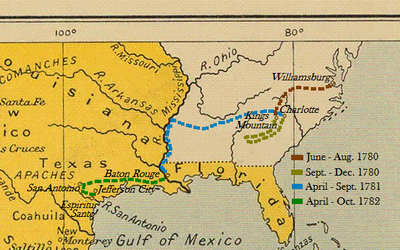
The Wilderness Walk, 1780 - 1782.
The Wilderness Walk was a mass migration of thousands of anti-British colonists from the Thirteen Colonies following their defeat in the North American Rebellion of 1775 - 1778. While a small number of anti-British colonists emigrated to France and Scandinavia, the majority chose to travel either overland or by ship to the Tejas region of New Spain, where they founded the settlement of Jefferson.
About a thousand colonists from New England and the Middle Colonies traveled down the Ohio River in 1780, paused at Fort Radisson in the Illinois Country to re-provision, then passed beyond the Mississippi River into Spanish Louisiana, where they were never heard from again. News of their fate reached the colonies in 1781, and discouraged any further attempts to settle in Louisiana.
While the northern colonists traveled down the Ohio, former general Nathanael Greene of Rhode Island led another party south from Virginia. Greene's party numbered between 3,000 and 5,000 colonists, including 500 to 600 Negro slaves. Apart from Greene, important members of this party included Alexander Hamilton of New York, James Madison, James Monroe, and Francis Lightfoot Lee of Virginia, Arthur Middleton and Edward Rutledge of South Carolina, Benjamin Rush and George Clymer of Pennsylvania, and Benedict Arnold of Connecticut. (Sobel erroneously lists John Morton of Pennsylvania as a member of Greene's party, though Morton died on 1 April 1777, seven months before the Battle of Saratoga.)
Greene chose to travel overland to Tejas rather than by ship because he hoped that blazing a trail through the wilderness would encourage subsequent overland migration. However, his plan was unsuccessful; all later settlers from the Thirteen Colonies would choose to take the sea route.
Before setting out, Greene addressed his lieutenants, saying, "We have a great duty, a responsibility I pray we can discharge. We shall be in strange lands and see strange people in our wandering. But our spirits are high and our resolve strong. Like Moses and the Israelites, we are eager for our walk through the wilderness." Greene's words would eventually give the migration the name it now bears.
Greene's party left Virginia on 23 June 1780, and arrived at Kings Mountain, North Carolina two months later. An attempt to reach Baton Rouge in Spanish Louisiana was unsuccessful due to disease and Indian attacks, and the party turned back and spent the winter in Charlotte, North Carolina. It was probably at this time that the party was joined by a thirteen-year-old boy named Andrew Jackson, who had been born and raised nearby.
The party set out again for Baton Rouge in April 1781, reaching it in September despite losing half their number. Greene's party was joined in November by a second group, numbering 800, including 300 slaves, which had traveled by ship from Charleston, South Carolina. In April 1782 the party left Baton Rouge, accompanied by 200 French-speaking Louisianans, and traveled overland to San Antonio, Tejas, which they reached in September. After traveling down the San Antonio River, Greene's party halted and established the settlement of Jefferson City near the Spanish mission town of Espiritu Santo and fort Presidio La Bahia.
When word of the successful settlement reached the Thirteen Colonies, a steady stream of more rebel sympathizers emigrated there. Following the establishment of the Confederation of North America in July 1782, some colonists who were unhappy with the new government also left to join Greene's settlement. In 1782 and 1783, an additional 7,000 emigrants, including 1,000 slaves, left the newly-established Southern Confederation for the settlement in New Spain. Between 1784 and 1789, 20,000 more settlers arrived, including 3,000 slaves, and Jefferson City was joined by the settlements of Arnold, Lafayette, and Henrytown. By the time of the Lafayette Convention of 1793, the Jefferson settlement had grown to 43,000 white settlers and 18,000 Negro slaves, vastly outnumbering the Spanish-speaking inhabitants of Tejas.
The Wilderness Walk gave its name to the Sons of the Wilderness Walk, an organization formed in 1920 to oppose the end of slavery in the United States of Mexico.
Sobel's sources for the Wilderness Walk include Richard Bennett's Nathanael Greene: Portrait of a Founder (Mexico City, 1929) and The First Group: Pioneers in the Wilderness (Mexico City, 1933); Wallace Gipson's The Wilderness Walk: Greene in the Desert (London, 1959); and David Christman's The Founding of Jefferson City: The First Three Decades (Mexico City, 1967), as well as such primary sources as Hamilton's Farewell to Change: Thoughts on Leaving the C.N.A. (New York, 1785), Arnold's Toward a New Jerusalem (Jefferson City, 1800), and Madison's The Course of Human Events (Jefferson City, 1819).
This was the Featured Article for the month of April 2022.
